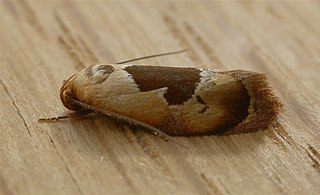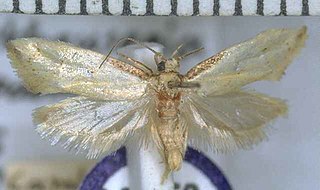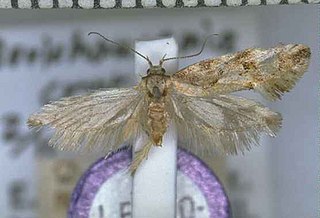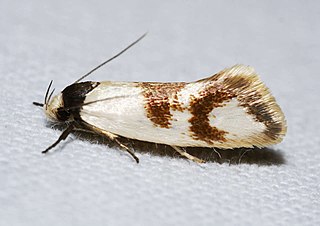
Hoplomorpha camelaea is a moth in the family Oecophoridae first described by Edward Meyrick in 1888. It is found in Australia, where it has been recorded from Victoria, Queensland, New South Wales and the Australian Capital Territory.

Lichenaula lichenea is a species of moth of the family Xyloryctidae. It is known in Australia from the Australian Capital Territory, New South Wales and Queensland.
Lichenaula calligrapha is a species of moth of the family Xyloryctidae. It is known from rainforests from northern Queensland to Victoria, although it has also been recorded from the Australian Capital Territory, New South Wales and Tasmania.

Pyrgotis eudorana is a species of moth of the family Tortricidae. It is endemic in New Zealand and has been observed in both the North and South Islands. However it is regarded as a rare insect. This species inhabits native forest. Larvae exclusively feed on Muehlenbeckia australis and adults are on the wing from November to April. Adults are attracted to light.

Tingena anaema is a species of moth in the family Oecophoridae. It is endemic to New Zealand and has been collected at Lake Wakatipu, Invercargill and Stewart Island / Rakiura. The adults of the species are on the wing in December.

Tingena apanthes is a species of moth in the family Oecophoridae. It is endemic to New Zealand and found in the North Island. The adults are on the wing from October to December. It appears associated with Leptospermum species and it has been hypothesised that the appearance of the adults of this species imitates faded Leptospermum leaves.

Tingena chloritis is a species of moth in the family Oecophoridae. It is endemic to New Zealand and has been found in the South Island. Larvae of this species feed on leaf litter. The adults of this species are light flyers and are attracted to light.

Tingena crotala is a species of moth in the family Oecophoridae. It is endemic to New Zealand and is found both in the North and South Islands. This species inhabits native forest and is on the wing in November and December.

Tingena hemimochla is a species of moth in the family Oecophoridae. It is endemic to New Zealand and has been observed in the North Island. Adults of this species are on the wing from December until March.

Tingena hoplodesma is a species of moth in the family Oecophoridae. It is endemic to New Zealand and has been found in the North and South Islands. T. hoplodesma prefers native beech forest habitat and adults are on the wing from January to March.

Tingena horaea is a species of moth in the family Oecophoridae. It is endemic to New Zealand and have been observed in both the North and South Islands. The adults are on the wing in January.

Tingena letharga is a species of moth in the family Oecophoridae. It is endemic to New Zealand and has been observed in Otago. Adults are on the wing in December and January.

Tingena macarella is a species of moth in the family Oecophoridae. It is endemic to New Zealand and is found on both the North and South Islands. Adults of this species are on the wing from November until February. This species is attracted to light and the larvae are litter feeders.

Antipterna trilicella is a species of moth in the family Oecophoridae, first described by Edward Meyrick in 1885 as Ocystola trilicella. It appears to be a moth endemic to Australia and confined to the east coast, occurring in Victoria, New South Wales and Queensland.

Antipterna euanthes is a species of moth in the family Oecophoridae, first described by Edward Meyrick in 1885 as Ocystola euanthes, with the female lectotype being found in the Wirrabara Forest, South Australia. It appears to be a moth endemic to Australia and in addition to South Australia is also found in Victoria, New South Wales, and Queensland.
Antipterna acrobaphes is a species of moth in the family Oecophoridae, first described by Edward Meyrick in 1885 as Ocystola acrobaphes. The holotype was collected in Sydney, New South Wales, in January 1878.
Antipterna glacialis is a species of moth in the family Oecophoridae, first described by Edward Meyrick in 1885 as Ocystola glacialis. The holotype was collected at Mount Lofty, South Australia.
Antipterna homoleuca is a species of moth in the family Oecophoridae, first described by Edward Meyrick in 1885 as Ocystola homoleuca. The lectotype for Ocystola homoleuca was collected at Wirrabara, South Australia, while that for Ocystola argophanes was collected in Brisbane, Queensland.
Antipterna monostropha is a species of moth in the family Oecophoridae, first described by Edward Meyrick in 1885 as Ocystola monostropha. The lectotype for Ocystola monostropha was collected at Blackheath, New South Wales.
Antipterna lithophanes is a species of moth in the family Oecophoridae, first described by Edward Meyrick in 1885 as Ocystola lithophanes. The lectotype for Ocystola lithophanes was collected at Deloraine, Tasmania. Holotypes for Alfred Jefferis Turner's synonyms were collected from Queensland and New South Wales.













